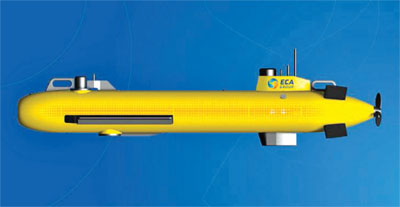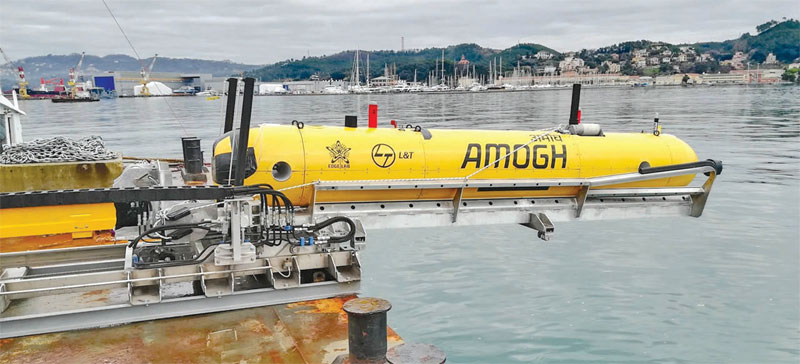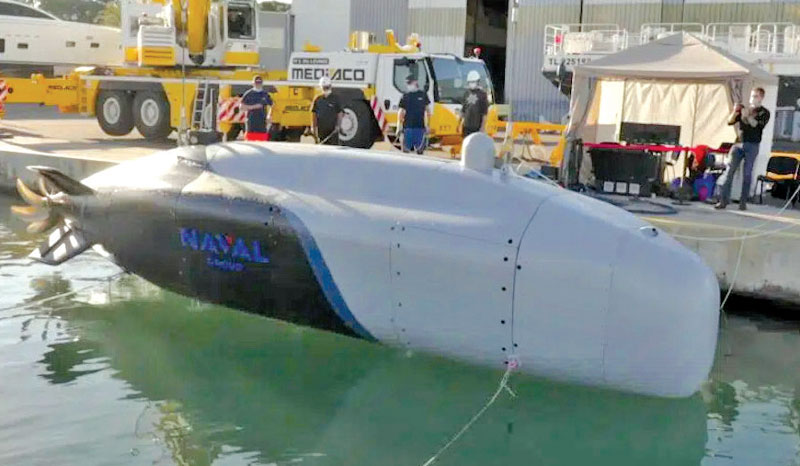Unmanned underwater vehicles can gather intelligence, enhance combat prowess of navies
Smruti Deshpande
Along with the armies and air forces the world over, navies too have started adopting unmanned technologies for operations. With several countries having dedicated resources for the development of these machines in order to dominate surfaces as well as sub-surfaces of oceans, the technology of Unmanned Underwater Vehicles (UUV) has gained pace. Artificial Intelligence (AI) is being used to enhance the autonomy of UUVs and enable them to make decisions based on the data they collect.

According to the latest data from The Insight Partners, with a 7.8 per cent CAGR, the UUV market share is worth USD 4.44 billion. The value, estimated in 2022, stood at USD 2.83 billion. The countries tied to this study include the US, Canada, Mexico, UK, Germany, Spain, Italy, France, India, China, Japan, South Korea, Australia, UAE, Saudi Arabia, South Africa, Brazil and Argentina.
The report suggests that geographically, the UUV market is segmented into North America, Europe, Asia Pacific, the Middle East & Africa, and South America. North America is the most prominent region in the market owing to a large number of manufacturers and suppliers in the region. Moreover, software companies are enhancing the capabilities of these vehicles by introducing advanced software. The report further suggested that countries in the Asia Pacific region such as China, Japan, South Korea and India are constantly spending substantial amounts in the development and procurement of advanced unmanned underwater robots.
UUVs have gathered steam because they can perform several tasks underwater with precision and speed. During mine countermeasures, UUVs can be used to detect and neutralise underwater mines. They can be equipped with specialised sensors that can detect mines and explosives and can be programmed to neutralise them. At the time of intelligence, surveillance and reconnaissance, these UUVs can be used to gather intelligence and conduct surveillance in underwater environments. They can be equipped with cameras, sensors and other instruments that can gather information about underwater infrastructure, enemy submarines among other targets.
Similarly, in cases of search and rescue, UUVs can be used to search for and locate missing persons or submerged vehicles. They can be equipped with sonar and other sensors that can detect objects underwater and can be remotely operated to search for targets in difficult or dangerous environments. Furthermore, they can even be used to map and survey underwater environments, including the seafloor and underwater infrastructure. They can be equipped with cameras and other sensors that can provide high-resolution images and data that can be used to create detailed maps and models.
UUVs can contribute greatly during warfare. UUVs can be used for offensive and defensive purposes in underwater warfare. They can be used to deliver weapons, conduct reconnaissance as well as disrupt enemy communications. If put together as a swarm, UUVs communicate and coordinate with each other to perform tasks in a coordinated manner.
The Indian Navy has been looking to develop such platforms given the strategic edge they promise. The Navy had stressed Underwater Domain Awareness (UDA) several times in the past. In 2021, then Vice Chief of the Naval Staff Vice Admiral Ashok Kumar said that to exploit the potential of unmanned technologies and platforms, the Navy had approved an ‘Unmanned Road Map.” UUVs or submersible unmanned vehicles are divided into two categories—remotely operated underwater vehicles (ROVs) and autonomous underwater vehicles (AUVs). While an ROV can be operated by a human being remotely, the same is not true for AUVs, which can operate entirely in an autonomous manner.

The former Navy vice chief had highlighted four main types of UUVs—the man-portable Autonomous Unmanned Vehicles (AUVs) with swarm functionality with an endurance of 10-20 hours, lightweight AUVs compatible with lightweight torpedo tubes onboard ships with an endurance of nearly two days, heavyweight AUVs compatible with in-service heavyweight tubes with an endurance of up to 3-4 days and high endurance AUVs with the capability to submerge for at least 15 days.
The commitment to development and induction of unmanned technologies was visible even during the annual press conference ahead of the Navy Day in December 2022, when the Chief of the Navy Staff Admiral R Hari Kumar said that the Indian Navy had already shared its unmanned requirements with the industry, which include aircraft as well as underwater vessels.
India’s gearing up of unmanned water tech came the same year as Indonesia reported that a local fisherman had discovered an unidentified ‘missile-like’ object in the waters off Selayar Island in Indonesia’s South Sulawesi province around December 2020 and handed it over to the Indonesian Navy, which in turn identified it as a glider-type autonomous underwater vehicle (AUV). Janes identified it as Haiyi, or ’Sea Wing’ autonomous underwater glider developed by the state-owned Chinese Academy of Sciences Shenyang Institute of Automation (CAS SIA) and manufactured and marketed by the Tianjin-based Deepfar Ocean Technologies. It was said that the Navy would go for importing underwater drones until the indigenous solutions are operational.

Recently in April 2023, Naval News reported that India’s ministry of defence has initiated a project to design and develop Extra Large Unmanned Underwater Vehicles (XLUUV). The Indian Navy is said to be interested in procuring 12 XLUUVs once a prototype is built and clears all trials. Quoting the document, the web portal stated, “According to the document, the XLUUV may have a maximum ‘length with payload’ of up to 50 meters, width of up to 5 meters, height no more than 10 meters and gross weight without ballast under 300 tons.” The XLUUV will be required to perform various tasks such as ISR, anti-submarine warfare, anti-surface warfare and mine warfare and will be deployed from a pier while conducting operations in shallow and restricted waters in returning to harbour on its own. ‘It must be capable of being transported by motherships and trailers on land.’
The XLUUV is mandated to have a maximum endurance of over 45 days using either Li-Po/Li-ion batteries or a fuel cell-based Air Independent Propulsion (AIP) system as the power source. A diesel generator may be used to recharge batteries. This project had been Approved-in-Principle (AiP) on January 16, 2023, with prototype development expected by 2025. Sensors fitted onto the XLUUV would include a flank-array sonar, towed array sonar, bow sonar, multi-beam echo sounder sub-bottom profiler, collision avoidance sonar, I band radar, ESM system and a periscope mast with EO/IR cameras.
The Indian industry has engaged itself with the development of UUVs. Last year, the Mazagon Dock Ltd came up with the concept of XLUUV which would be useful in performing periodic communication, payload deployment, executing pre-programmed missions and transiting back to base. It will be equipped with internal and external payload volumes which can be reconfigured based on mission requirements. It has been reported that these XLUUVs will carry the DRDO’s high endurance UAV as one of its payloads.
The DRDO too has been on track for developing this technology. For instance, in 2013, it tested an AUV at about 100 metres below sea level. The four-metre long, 1.4-metre wide, flat fish-shaped vehicle can travel at a speed of about 7 km per hour at depths of up to 300 metres below sea level.

Larsen and Toubro (L&T) showcased the Adamya, Amogh and Maya AUVs at DefExpo 2020. The Adamya AUV can be launched from submarines with 533 mm torpedo tubes and is touted to have an operational endurance of over eight hours at four knots and can descend up to 500 meters. This AUV has a length of five meters and can be submarine-launched without making significant modifications to the submarine. This AUV offering has been described as being able to be launched from surface ships using the launch and recovery system. According to the recently signed Memorandum of Understanding (MoU), L&T together with the Bangalore-based New Space Research and Technology (NRT) will develop UUVs for surveillance purposes.
The DRDO is also contributing to the indigenous UUV development efforts with its Underwater Launched Unmanned Aerial Vehicles (ULUAV). The organisation aims to design and develop critical technologies to launch UAVs from the North Atlantic Treaty Organisation (NATO)-standard torpedo tubes of submerged undersea platforms.
Around the Globe
On a global platform, there are several key vendors of UUVs. The US, China, Germany and France among others are key developers of this technology.
Naval News early this year reported that the world’s largest submarine drone was being built in Germany. The German shipbuilder Thyssenkrupp Marine Systems TKMS MUM (Modifiable Underwater Mothership) will be the largest autonomous underwater vehicle in the world. The MUM will have a ‘flat fish’ type design. “The TKMS conceived this as a civilian design. In essence it is a large flexible work horse UUV able to incorporate user-defined payloads,” Naval News said. The potential roles include offshore services such as inspection, maintenance and repair. It can also aid exploration of offshore oil and gas fields, or marine minerals among others.
In 2022, the US Navy’s Naval Sea Systems Command (NAVSEA) unveiled its first-ever Orca Extra Large Unmanned Undersea Vehicle (XLUUV). The ORCA project was awarded to Boeing in a USD 274 million contract in February 2019 for five drones. The Orca is designed to conduct mine countermeasures, anti-submarine warfare, anti-surface warfare and electronic warfare missions.
It has a top speed of eight knots (14.8 kms/9.2 miles per hour) and a maximum range of 12,038 kms. The design of this drone is based on Boeing’s 51-foot Echo Voyager and has an open architecture to enable future integration of advanced technologies.
France’s Naval Group is one another major player in this area of defence systems. During the fifth edition of the Naval Innovation Days, the group unveiled the Extra Large Unmanned Underwater Vehicle (XLUUV) demonstrator. In October 2021, answering a question by Naval News, the Naval Group’s CEO Pierre Eric Pomellet said: “The demonstrator really came out of Naval Group’s research laboratories to put together technologies and demonstrate the interest of a system such as this one to complement a naval force. So, we are unveiling it today, but obviously a lot of government and research players know what we have done, and we are going to discuss with them how we can follow up on this type of technology and demonstration. This project is part of the self-investment that the Naval Group is making to go beyond the simple technology.”
The demonstrator is designed primarily as a platform to conduct Intelligence, Surveillance and Reconnaissance (ISR) mission. Future missions may include mine counter measure (MCM) or anti-submarine warfare (ASW) as the company’s F21 heavy weight torpedo (HWT) can fit in this weapons bay.
Further, China is revealed to have ‘at least five designs in the water, many more than any other navy.’
Janes reported last year that Atlas Elektronik UK will supply the Royal Navy with autonomous underwater vehicles, the UK Defence Equipment and Support (DE&S) Mine Hunting Capability (MHC) team has awarded a GBP 32 million (USD 41.6 million) contract to Atlas Elektronik UK (AEUK) for autonomous mine-hunting systems. The company will supply the Royal Navy with three MHC autonomous underwater vessel (AUV) systems. Each system will encompass three SeaCat vehicles configured with a synthetic aperture sonar (SAS) system and Seebyte Neptune’s advanced planning and analysis software, comprising nine vehicles.
The SeaCat is a highly modular hybrid AUV combining the advantages of AUV and ROV technology. In addition to AUV functionality, the SeaCat is able to fly with a fibre optic cable connection in order to secure a real time sensor data transmission to the operator console. Emphasis is placed on the SwapHead Technology which enables flexible and fast adaptation to a number of various missions and tasks. The SeaCat can be equipped with several sensors of choice.

Atlas Elektronik also has a UUV named Seafox. The UUV was developed based on the expendable mine disposal vehicle (EMDV) principle and is operated primarily by the Royal Navy, US Navy and German Navy. The Seafox can also be used in damage estimation, intelligence, route survey, maritime boundary control and harbour surveillance missions.
Officials of the Naval Undersea Warfare Center (NUWC) in Newport announced last year that a USD 173.2 million contract was extended to Saab to build, test and deliver drones to help Navy ASW experts practice their skills from surface warships, submarines, helicopters and fixed-wing aircraft. These Saab UUVs are called the MK 39 Mod 2 expendable mobile antisubmarine warfare training targets (EMATT).
UUV experts at Lockheed Martin Corp. in 2015 upgraded three versions of the company’s Remote Multi-Mission Vehicles (RMMV) UUVs for use in countermine warfare aboard the US Navy’s Littoral Combat Ship.
The RMMV UUV is based on the Lockheed Martin AN/WLD-1 Remote Minehunting System, a 23-foot-long semi-autonomous semi-submersible diesel-powered submarine with a snorkel and antenna mast that detects difficult-to-find moored and bottom sea mines.
At the DSEI Japan 2023 near Tokyo, ATLA was showcasing for the first time its own XLUUV project. The Japanese MoD’s agency calls it officially a ‘long endurance, multi role UUV research prototype.’
South Korea’s Agency for Defence Development (ADD) announced last year that it had successfully conducted an “operational demonstration” of the anti-submarine warfare unmanned underwater vehicle (ASWUUV) off the coast of Tongyeong, South Korea.
In December 2022, Australia unveiled an underwater vehicle named the ‘Ghost Shark’. A 2.8 tonne ‘Dive-Large Displacement’ (LD) UUV test prototype was handed over to the Royal Australian Navy (RAN) from the US.
As more countries in the West as well as Asia have started investing in unmanned underwater resources, intelligence gathering as well combat prowess have gained a renewed meaning in naval warfare.

